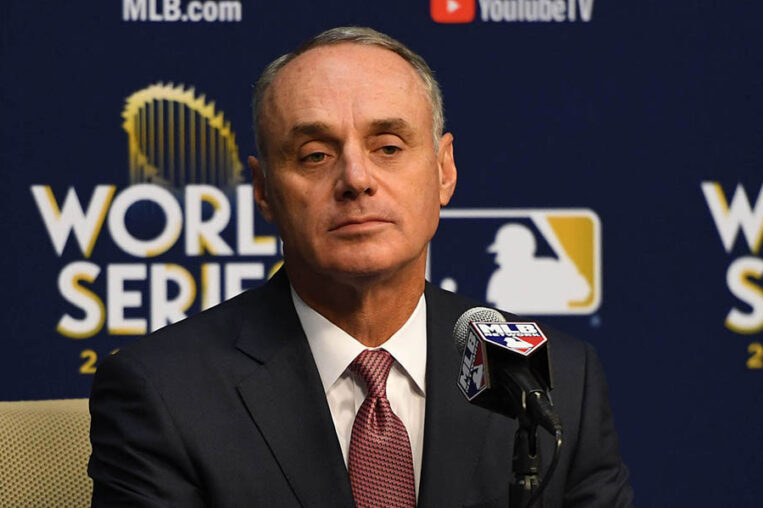
It’s a new week, so what can we expect in the Major League Baseball lockout? According to Jon Heyman of MLB Network, MLB owners are set to meet in Orlando, Florida from Tuesday through Thursday. The owners may submit a proposal to the Major League Baseball Players Association during or after that meeting.
Bob Nightingale of USA Today adds there is the possibility of a meeting between the two sides this week.
The next negotiating session has yet been scheduled but they could meet next week in Florida. The owners have their scheduled quarterly meetings Tuesday through Thursday in the Orlando area while the union plans to start meeting with players next week, including stops in Florida.
One person with direct knowledge of the negotiations told USA TODAY Sports that union representatives aren’t going to Florida to specifically engage in negotiations, but will be available if a session is scheduled.
If the owners do submit a proposal, it will be one the players have expected for over a week. The owners had indicated they would make a counteroffer to the union’s most recent proposal last week, but they did not do so. Rather, they offered federal mediation, which the players rejected. That resulted in a full deployment of the public relations machines on both sides, with the owners questioning how the players could reject mediation if the union is fully committed to a settlement, while many players took to social media saying that the owners are not negotiating in good faith.
And so it goes on, and the days continue to come off the calendar. Spring training was supposed to begin on February 15, with games taking place less than two weeks later. Neither of those will happen, and if there is not a new Collective Bargaining Agreement by March 1, the season will likely be delayed.
Commissioner Rob Manfred has become a prime target for players and fans on social media, and he certainly has been instrumental in the current situation, choosing to impose a lockout on December 2 to jumpstart negotiations toward a new CBA. That strategy has backfired on the surface, as the players and owners have not reached an agreement, the talks have stalled, and true to form, both the owners and the union began trying to win the case in the court of public opinion by accusing the other side of being the reason for the deadlock.
I say it has backfired “on the surface” because there is no agreement, and spring training, at a minimum, will not start on time. Though MLB issued a statement that its intent is to have fans at spring training and regular season games per the established schedule, it’s fair to question if those really are MLB’s primary objectives.
As we know, Manfred is paid by the owners. His driving force is to strike a deal with the players that aligns with the best interests of the owners, and if that means waiting the players out and sacrificing games, he’s willing to do that. At some point, waiting will work against the owners (when the lack of revenue becomes an issue for paying fixed operating expenses, etc.), and that may change MLB’s strategy. But until that time, using the calendar as a perceived leverage point to get a better deal for the owners supersedes any interest in starting the season so fans can go to spring training and regular season games.
MLB seems to operate on a strategy of making decisions with short-term interests in mind. That’s not uncommon in the business world. It’s customary for a new CEO to join a corporation and make decisions to immediately optimize shareholder wealth and meet investors’ earnings expectations. At times, these decisions run contrary to the long-term interests of the business (perhaps a rapid downsizing of the work force to help the bottom line in the near-term, but leaving the organization exposed in the medium and longer-term).
Think about some of the ways in which MLB operates. Every year, we hear about the starting times of postseason games and how they all but rule out viewing by the youngest fans. The networks pay handsomely to have the games on in prime time (a short-term “win”), but the game is not investing in its future. The option would be to make the postseason games more accessible to younger fans (long-term investment), but the reduced revenue would conflict with the immediate benefit of realizing optimal television revenue.
It feels like this is the strategy Manfred and his team are taking now. Hold out, get the best possible deal for today (and the next few years), without regard to potential long-term damage to the game (by alienating fans and chipping away at an already-shrinking customer base).
That brings us back to this week in MLB. Maybe MLB and the MLBPA will surprise us and make progress toward a new CBA. The more likely scenario is that the owners make a proposal that shows little movement, and the rhetoric starts again on both sides.
Meanwhile, it will be March 1 in three weeks. That’s not much time to bridge gaps in many areas, especially when the negotiations are moving at a snail’s pace.
It’s ironic that the players and owners may meet in Florida, the location where many of wish we could be in the near future, watching baseball under sunshine and palm trees.















